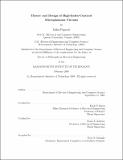| dc.contributor.advisor | Erich P. Ippen and Franz X. Kärtner. | en_US |
| dc.contributor.author | Popović, Miloš, 1977- | en_US |
| dc.contributor.other | Massachusetts Institute of Technology. Dept. of Electrical Engineering and Computer Science. | en_US |
| dc.date.accessioned | 2008-11-07T14:09:33Z | |
| dc.date.available | 2008-11-07T14:09:33Z | |
| dc.date.copyright | 2008 | en_US |
| dc.date.issued | 2008 | en_US |
| dc.identifier.uri | http://hdl.handle.net/1721.1/42911 | |
| dc.description | Thesis (Ph. D.)--Massachusetts Institute of Technology, Dept. of Electrical Engineering and Computer Science, 2008. | en_US |
| dc.description | This electronic version was submitted by the student author. The certified thesis is available in the Institute Archives and Special Collections. | en_US |
| dc.description | Includes bibliographical references (p. 285-302). | en_US |
| dc.description.abstract | Advanced microphotonic device designs in strongly confining silicon and silicon nitride waveguides, novel photonic device concepts, and the first experimental demonstrations of these structures are described. They show a progression of new optical signal processing capabilities that enable chip-scale microphotonic routers for high bandwidth and fine granularity optical wavelength routing networks. Rigorous theoretical models are developed that enable the design of efficient high-index-contrast (HIC) microphotonic components and set theoretical bounds for their capabilities. They take into account new, coupling induced resonance-frequency shifting and parasitic loss effects. Based on microring resonators and HIC silicon and silicon nitride waveguides, the first telecom-grade microphotonic channel add-drop filters are demonstrated, including novel, dispersion-free switchable and widely tunable designs. Several new classes of optical devices are proposed. The first, universally balanced interferometers, enable filters capable of "fully transparent" tuning and increased accessible wavelength range, facilitate a novel proposed photonic-circuit "hot-swapping" functionality, and approximate an optical nearinverse operator in a general way. The second, loop-coupled resonators, enable optimally sharp filters and flat-top, dispersionless light-slowing structures that are not limited by the Kramers-Kronig amplitude-dispersion tradeoff. A third class provides a general approach to disabling both the amplitude and phase response of resonant systems to achieve a fulltransparency off state. They allow a robust integrated solution to hitless, errorless filter tuning and wavelength-reach expansion in filters, topical problems of considerable technological importance. | en_US |
| dc.description.abstract | (cont) Taken together these developments permit a complete tunable/reconfigurable optical add-drop multiplexer (T/R-OADM) to be constructed on a silicon chip, with performance well beyond that of current technology. Such a demonstration device was designed and fabricated. This work also provides new general building blocks for microphotonic circuits, and design guidelines for strong confinement photonics. | en_US |
| dc.description.statementofresponsibility | by Miloš Popović. | en_US |
| dc.format.extent | 358 p. | en_US |
| dc.language.iso | eng | en_US |
| dc.publisher | Massachusetts Institute of Technology | en_US |
| dc.rights | M.I.T. theses are protected by
copyright. They may be viewed from this source for any purpose, but
reproduction or distribution in any format is prohibited without written
permission. See provided URL for inquiries about permission. | en_US |
| dc.rights.uri | http://dspace.mit.edu/handle/1721.1/7582 | en_US |
| dc.subject | Electrical Engineering and Computer Science. | en_US |
| dc.title | Theory and design of high-index-contrast microphotonic circuits | en_US |
| dc.title.alternative | Theory and design of HIC microphotonic circuits | en_US |
| dc.type | Thesis | en_US |
| dc.description.degree | Ph.D. | en_US |
| dc.contributor.department | Massachusetts Institute of Technology. Department of Electrical Engineering and Computer Science | |
| dc.identifier.oclc | 243866140 | en_US |
